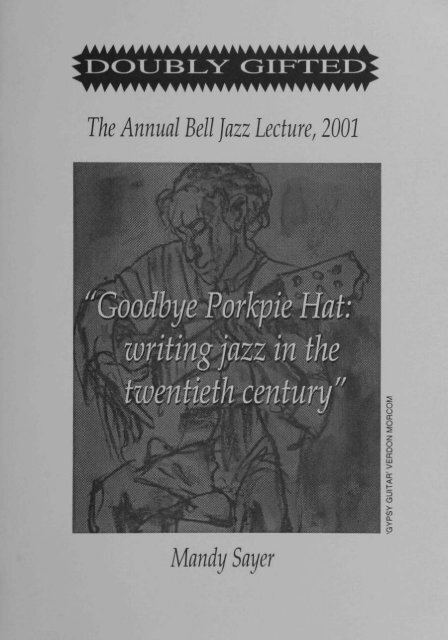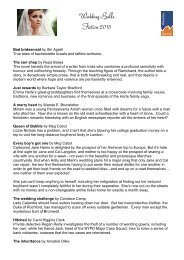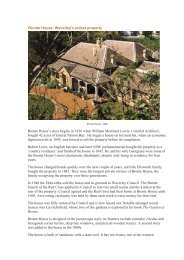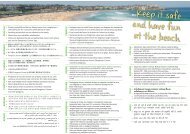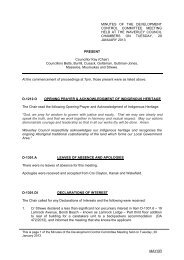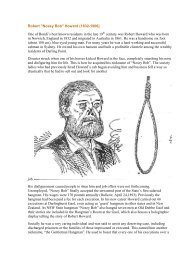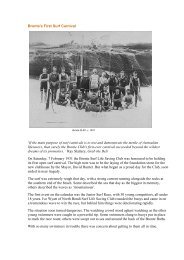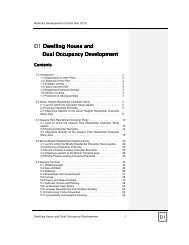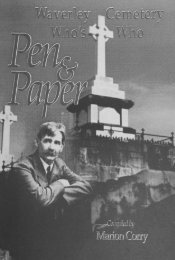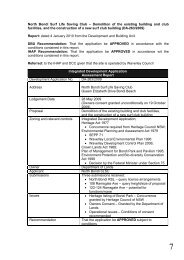The Annual Bell Jazz lecture, 2001 Mandy Sayer - Waverley Council
The Annual Bell Jazz lecture, 2001 Mandy Sayer - Waverley Council
The Annual Bell Jazz lecture, 2001 Mandy Sayer - Waverley Council
You also want an ePaper? Increase the reach of your titles
YUMPU automatically turns print PDFs into web optimized ePapers that Google loves.
AAAAAAAAAA.AAAAAAkkAAAA.AAAAAAAAA<br />
DOUBLY GIFTED<br />
• TT TTTTT ••••TTTTTTTTTTTTTTTTr TT<br />
<strong>The</strong> <strong>Annual</strong> <strong>Bell</strong> <strong>Jazz</strong> <strong>lecture</strong>, <strong>2001</strong><br />
<strong>Mandy</strong> <strong>Sayer</strong>
<strong>The</strong> <strong>Annual</strong> <strong>Bell</strong> <strong>Jazz</strong> <strong>lecture</strong>, <strong>2001</strong><br />
<strong>Mandy</strong> <strong>Sayer</strong><br />
<strong>The</strong> Ninth <strong>Annual</strong> <strong>Bell</strong> jazz Lecture<br />
Delivered 22nd September, <strong>2001</strong><br />
<strong>Waverley</strong> Library
© <strong>Mandy</strong> <strong>Sayer</strong><br />
ISBN 0-9585157-5-1<br />
Published by and printed at <strong>Waverley</strong> Library<br />
32-48 Denison Street, Bondi Junction, 2022<br />
Telephone: (02) 93861111<br />
Fax: (02) 9386 7700
Introduction<br />
<strong>The</strong> <strong>Annual</strong> <strong>Bell</strong> Lecture in <strong>Jazz</strong> has now reached its ninth year in <strong>2001</strong>. Once<br />
again the Doubly Gifted Committee wishes to thank the staff of the '<strong>Waverley</strong><br />
Library, the Friends of <strong>Waverley</strong> Library and the <strong>Waverley</strong> <strong>Council</strong> for making<br />
both the Doubly Gifted Exhibition and the Lecture possible.<br />
<strong>The</strong> Exhibition and the <strong>Bell</strong> Lecture in jazz were initiated by the late Harry Stein<br />
and therefore the Doubly Gifted Committee continues to present these as a tribute<br />
to his memory and as a tribute to the great Australian jazz musician, Graeme <strong>Bell</strong>.<br />
This year we are honoured to have as our <strong>lecture</strong>r, a well-known and highly -<br />
respected successful author, <strong>Mandy</strong> <strong>Sayer</strong>. She has published a number of novels<br />
and continues to delight her reading public with a variety of subjects.<br />
<strong>Mandy</strong> <strong>Sayer</strong> is the daughter of jazz drummer, the late Gerry <strong>Sayer</strong>, who<br />
travelled overseas with <strong>Mandy</strong> at his side. She has experienced a most unusual<br />
jazz life and will surely draw on some of these experiences to dehver a very<br />
informative and entertaining <strong>lecture</strong>.<br />
<strong>Mandy</strong> <strong>Sayer</strong> will be introduced by last year's <strong>lecture</strong>r Peter J.F. Newton.<br />
Kate Dunbar<br />
Co-Convenor<br />
Doubly Gifted Committee
W<br />
<strong>Mandy</strong> <strong>Sayer</strong><br />
<strong>Mandy</strong> <strong>Sayer</strong> attended twelve public schools before touring the<br />
U.S. as a street performer with her jazz drummer father. She<br />
later studied tap dance with Cookie Cook and Brenda Buffalino<br />
in New York and joined the Bill Evans Dance Company. She has<br />
received a BA and MA from Indiana University, where she<br />
taught fiction and poetry writing for a year.<br />
<strong>Sayer</strong> is the author of three novels. Mood Indigo (winner of the 1989<br />
Australian / Vogel Literary Award), Blind Luck, and <strong>The</strong> Cross. Her<br />
memoir, Dreamtime Alice, was published to critical acclaim in<br />
Australia, the U.S., and the U.K. in 1998, and has since been translated<br />
into several European languages, winning the National Biography<br />
Award, the New England Booksellers' Discovery Award in the U.S.,<br />
and Australian Audio Book of the Year. Dreamtime Alice is soon to<br />
be a feature film that <strong>Sayer</strong> has adapted for the screen, produced by<br />
<strong>The</strong> Piano's Jan Chapman. <strong>Sayer</strong> co-edited (with Louis Nowra) In the<br />
Gutter, Looking at the Stars, an anthology representing two hundred<br />
years of literature set in Sydney's Kings Cross. Her collection of<br />
linked short stories. Fifteen Kinds of Desire, was published this year<br />
from Random House Australia. This year <strong>Sayer</strong> will complete her<br />
Doctorate in the Creative Arts. She lives in Sydney.<br />
Graeme <strong>Bell</strong><br />
<strong>The</strong> Doubly Gifted Committee and <strong>Waverley</strong> Library have<br />
named this <strong>lecture</strong> series on jazz, the <strong>Bell</strong> <strong>Jazz</strong> Lectures, in<br />
honour of Graeme <strong>Bell</strong>'s outstanding contribution to jazz in<br />
Australia and abroad over the last fifty years. He is an<br />
outstanding pianist, excellent band leader and composer of note.<br />
Graeme is also a talented artist who has exhibited in the Doubly<br />
Gifted exhibitions of visual art works by jazz musicians, as well as<br />
contributing to other exhibitions.
Goodbye Porkpie Hat: Writing <strong>Jazz</strong> in the 20th Century<br />
<strong>The</strong> famous bassist and composer, Charles Mingus, was onstage at a<br />
New York Club when a man crept up and whispered in his ear that the<br />
virtuoso tenor saxophonist, Lester Young, had died. Mingus, who was<br />
on the piano during that set, and who was one of Young's greatest<br />
admirers, abruptly stopped playing the tune the band was halfway<br />
through and seguewayed in to a piece of music no one had heard before.<br />
<strong>The</strong> tempo was gradual and haunting, and the melody cut a slow,<br />
sinuous path around the other musicians. <strong>The</strong> rest of the band listened<br />
hard and picked up the changes-not knowing that Mingus was in fact<br />
inventing the tune as he went along, and that this improvised elegy to<br />
Lester Yoxmg would eventually become the jazz classic, "Goodbye Pork<br />
Pie Hat."<br />
I begin with this anecdote because I'm here today to talk about<br />
jazz and it's influence on 20th Century literature, and to me the story of<br />
how "Goodbye Pork Pie Hat" came to be written has a lot in common<br />
with prose and poetry inspired by jazz. <strong>Jazz</strong>-influenced poetry, for<br />
example, has often been improvised and invented in tandem with<br />
instrumentalists, whether we're looking at the Beat literature of the 1950s<br />
America, or the rap-based performance poetry of the 80's and 90's. Just<br />
as Mingus was moved to compose "Goodbye Porkpie Hat" out of grief<br />
and longing for a particular musician and the place and time Lester<br />
Yotmg represented, most writers who've incorporated jazz into their<br />
work have done so with a similar impulse: the subject matter of the poem<br />
or novel is a (frequently tragic) jazz musician, and the tone of the work is<br />
usually wistful and nostalgic. Take, for example, the last stanza of Frank<br />
O'Hara's poem, "<strong>The</strong> Day Lady Died", written after he'd heard that Billy<br />
Holiday had passed away:"... and a NEW YORK POST with her face on<br />
it / and I am sweating a lot by now and thinking of / leaning on the John<br />
door in the FIVE SPOT / while she whispered a song along the keyboard<br />
/ to Mai Waldron and everyone and I stopped breathing" Another good<br />
example is Yusef Komunyakaa's elegy to pianist <strong>The</strong>lonious Monk,<br />
"<strong>The</strong>lonious is dead .. . <strong>The</strong> ghost of Be-Bop / from 52nd Street, / footprints<br />
in the snow. / Damn February. / Let's go to Minton's / & play<br />
'modem malice' / till daybreak. Lord, / there's <strong>The</strong>lonious / wearing<br />
that old funky hat / pulled down over his eyes." Another way in which<br />
the "Goodbye Porkpie Hat" story mirrors jazz-influenced literature is<br />
through it's title; in coming up with the name of the tune, Mingus, like a<br />
deft poet or novelist, creates a metaphor with the "Hat", and at the same<br />
time creates an internal rhyme (Goodbye-Porkpie). If anybody bothered<br />
to "scan" the title they'd realised it imitates the rhythm of a classical<br />
English poetic form, the "trochaic trimeter."<br />
1
But we're not going to get too technical today. With this talk I'd<br />
like to concentrate on the main ways in which jazz has shaped 20th<br />
Century literary forms, and a little about the ways in which it has<br />
influenced my own writing. I'U also be improvising on the idea that as the<br />
music evolved throughout the decades and became more diversified and<br />
intemational, so too did the literature that was influenced by it.<br />
My own interest in jazz springs from my father, Gerry, who was a<br />
Sydney-based jazz drummer for almost seventy years. Just after I was<br />
bom we lived in a house in Stanmore and Gerry had the entire bathroom<br />
ripped out and converted into a sound proof music room so he could<br />
practise on a full kit without the neighbours complaining. It also proved<br />
to be a godsend to my mother, who has since told me that she would<br />
leave me in there as a baby if I cried while she was cooking dinner.<br />
Meanwhile, my older sister, brother, and I were bathed in an iron tub in<br />
the kitchen and used a toilet at the end of the veranda. As I was growing<br />
up, the music room assumed a separate, mythic presence in the house;<br />
the door was always closed and my father was usually on the other side<br />
of it, trying to perfect his double ratamacues. My mother used to leave<br />
his lunch at the door but sometimes he forgot to eat it and, as the hours<br />
passed by, I'd watch a slow, gelatinous skin form over the the surface of<br />
the pea and ham soup, or the gravy covering two sausages. <strong>The</strong> music<br />
room was also the place where I was sent when I was bad and some of<br />
my first memories are of crawling beneath the side drum and thrilling at<br />
the way in which the snares whispered and thrummed back at me when I<br />
pursed my lips towards it and made a sound.<br />
Curiously, there were very few books in the house—except several<br />
Little Golden Books packaged for children. <strong>The</strong> first real stories I ever<br />
heard were not from the Grimm Brothers or Hans Christian Andersen,<br />
but from the man who lived mostly in the soundproof room. <strong>The</strong> stories<br />
my father told were always rollicking good fun and, when he did finally<br />
drag himself away from his kit, he often mythologised himself and his<br />
mates over sweating glasses of beer and unfiltered cigarettes. Like all<br />
good musicians, his timing was impeccable, and his tales were like<br />
looping saxophone solos with improbable pauses and tensions that kept<br />
driving towards some hilarious crisis. <strong>The</strong>re was one about the day he<br />
flew a Tiger Moth aeroplane beneath the Sydney Harbour Bridge in the<br />
'30's; another about the time he sold a radio to a deaf woman. <strong>The</strong>n there<br />
was the time he and his great friend, saxophonist Rolf Pommer, were part<br />
of the eighteen-piece Trocadero orchestra during the '50's. Rolf, a gifted<br />
musician and dedicated alcoholic, stood up one night and walked to the<br />
front of the bandstand to play his solo. He played the first chorus
eautifully, paused, turned, discreetly vomited into the beU of the<br />
baritone sax, straightened up and continued his solo. As Gerry always<br />
boasted; He didn't miss a beat.<br />
Since he was born in 1920 with a hare lip and a cleft palate—which,<br />
ironically, made it difficult for him to learn how to speak—he spent the<br />
first seven years of his life in hospital without any formal education.<br />
This setback, coupled with his queer, breathy voice and scarred lips, with<br />
the hole in the roof of his mouth, led him to loathe the school into which<br />
his parents had suddenly dropped him; all the other kids his age were<br />
three years ahead of him and teased him about his slow ways in class and<br />
the way he seemed to only talk through his nose. Consequently, he<br />
buried himself in the study of music and left school at fourteen, barely<br />
literate. By 1948, Tempo magazine had named him one of Australia's best<br />
drummers. He could play any piece of music that was placed in front of<br />
him—as the musos often say, he could read fly shit at ten paces—yet he<br />
found it hard to write his own name, let alone settle down with a good<br />
book or magazine.<br />
For me, his youngest child and second daughter, all this had<br />
interesting implications. From the time I could get a pencil in my hand<br />
and begin to manipulate the letters of the alphabet, I was writing.<br />
Gradually phrases bled into poems, and poems augmented into stories,<br />
and stories sprawled out into the first hesitant chapters of a Gothic novel.<br />
At the same time, I was becoming attuned to the rhythms of my father's<br />
voice and jazz, to the fascinating plots of his life, and I think the music<br />
he played and the stories he told have had more of an effect upon my<br />
work than any particular book or teacher.<br />
Poetry and prose can be influenced by jazz in a number of ways.<br />
<strong>The</strong> first, most straightforward is when the work uses a single jazz<br />
musician or the jazz subculture as subject matter; a novel, say, about the<br />
difficult life of a gifted pianist, as in Frank Conroy's Body and Soul, or<br />
Philip Larkin's poem For Sydney Bechet. Usually the work is a tribute<br />
or an elegy to a single jazz musician, whether real or invented.<br />
<strong>The</strong> second way is when a writer is influenced by jazz rhythms and<br />
musical devices, when the language attempts to approximate the subject<br />
matter of jazz, as in the fiction of James Baldwin; "He and the piano<br />
stammered, started one way, got scared, stopped; started another way,<br />
panicked, marked time, started again; then seemed to have found a<br />
direction, panicked again, got stuck." (from the short story Sonny's<br />
Blues). Here, Baldwin is not merely writing about a troubled pianist, the<br />
placement and syntax of the prose allows the reader to hear the<br />
staccato-like metre of the music and its struggle to articulate itself.
Poet Etheridge Knight used jazz rhythms in an entirely different way in<br />
his poem / and Your Eyes:<br />
And I and your eyes<br />
Draw roiuid about a ring of gold<br />
And shout their sparks of fire<br />
And I and your eyes<br />
Hold untold tales and conspire<br />
With moon and sun to shake my soul.<br />
<strong>The</strong> long pause Knight employs on the first and third lines creates a kind<br />
of musical tension, a delicious hesitation that could be compared to<br />
spaces pianist Count Basie left in his music, or the silences that can be<br />
heard in a good drum solo.<br />
<strong>The</strong> third way in which writers have used jazz in their work is on<br />
the level of structure. Poets in particular have been influenced by the<br />
12-bar blues form of writing lyrics, while jazz-inspired novels veer away<br />
from a linear mode of storytelling and instead employ multiple narratives<br />
or potnts-of-view that often accumulate into a kind of literary riff, or a<br />
set of improvisations on a particular theme. While I myself have used<br />
jazz musicians as the subjects of my novels, and have tried to use<br />
language that approximates the rhythms of jazz, it is probably on the<br />
level of structure that jazz plays itself out in my work the most. My<br />
novel <strong>The</strong> Cross, for example, is a series of monologues from seven main<br />
characters, all of whom narrate, from wildly different perspectives, the<br />
last six months of the life of a woman called Gina Delgado, who is loosely<br />
based on the famous Kings Cross heiress and activist Juanita Nielsen.<br />
<strong>The</strong> characters essentially tell the same story, but add their own<br />
embellishments, inventions, asides, and interpretations—so the thrust of<br />
the narrative is not the events themselves but how each narrator<br />
improvises on the theme and is able to reinvent it. I employed a similar<br />
technique in my most recent book, 15 Kinds Of Desire, a collection of<br />
linked short stories, in which a narrative line resolves itself in one tale,<br />
only to remerge in another in a totally new or surprising way. Unlike my<br />
first two novels, or my memoir Dreamtime Alice, <strong>The</strong> Cross and 15 Kinds of<br />
Desire, don't use jazz or jazz musicians as subject matter—there's<br />
hardly a mention of the music in either of them—yet the structure of each<br />
is informed by interpretive nature of improvisation. In this sense,<br />
someone like William Faulkner, with novels such as As I Lay Dying and<br />
<strong>The</strong> Sound and the Fury, can also be read as a "jazz-writer".
<strong>Jazz</strong>-inspired writing has always been associated with marginalised<br />
characters—with the underdog, the misfit, the outsider. This shouldn't<br />
come as a surprise, as the music itself sprung from the spirituals and<br />
work songs of the most marginalised American people during the early<br />
20th century. Author Ralph EUison equated being black at that time with<br />
being totally invisible, and in his cult novel Invisible Man the narrator<br />
finds a curious kinship in the music of Louis Armstrong: "Sometimes now<br />
I listen to Louis while I have my favourite dessert of vanilla ice cream and<br />
sloe gin. I pour the red liquid over the white mound, watching it glisten<br />
and the vapor rising as Louis bends the military instrument into a beam<br />
of lyrical sound. Perhaps I like Louis Armstrong because he's made<br />
poetry out of being invisible .... And my own grasp of invisibility aids<br />
me to understand his music. . . . Invisibility, let me explain, gives one a<br />
slightly different sense of time, you're never quite on the beat.. ."<br />
This idea of the misfit, the outsider, has been with jazz and jazz-inspired<br />
writing from the very early days, when the musical form was first<br />
rebelling against the prevailing European notions of "high art".<br />
<strong>The</strong> first writer to be influenced by jazz directly was American<br />
poet, Langston Hughes, who was a figurehead in the black movement of<br />
the 1920s commonly referred to as the Harlem Renaissance. This<br />
renaissance was a decade-long exploration of African-American arts,<br />
history, and culture that questioned the relevance of European values,<br />
and instead sought to develop and celebrate an alternative, black<br />
aesthetic. Even though the Harlem Renaissance had an impact upon<br />
black writers, painters, theatre people and scholars, composer and pianist<br />
Eubie Blake maintained that music—specifically jazz and the blues—was at<br />
the centre of the movement. During the 1920's, New York whites were<br />
flocking uptown to Harlem to hear the new, exciting music, but black<br />
intellectuals of the time still underestimated the value of jazz and the<br />
blues, hearing the music as a form of primitive folk art rather than as a<br />
significant expression of the African-American experience. It wasn't until<br />
Langston Hughes interpreted the blues as a metaphor for black life that<br />
jazz found significance with black intellectuals. In his essay. <strong>The</strong> Negro<br />
Artist and the Racial Mountain, he writes; "Let the blare of Negro jazz<br />
bands and the bellowing voice of Bessie Smith singing blues penetrate the<br />
closed ear of the colored near-intellectuals until they listen and perhaps<br />
understand." However, it is in Hughes' poetry itself that one can find<br />
the music he loved and so believed in, which mostly consists of poetic<br />
transpositions of the blues in terms of form and subject matter. Take, for<br />
example, the first stanza oi Morning After, which assumes A/A/B<br />
structure usually associated with a musical twelve-bar blues:
I was so sick last night I<br />
Didn't hardly know my mind<br />
So sick last I<br />
Didn't know my mind<br />
I drunk some bad licker that<br />
Almost made me blind.<br />
<strong>The</strong> poem continues in its A/A/B structure for another two stanzas and,<br />
if it were read on top of a traditional blues, could function perfectly as a<br />
twelve-bar blues lyric. Unlike his predecessors, Hughes believed in<br />
narrowing the distinctions between "low" and "high" art.<br />
This aesthetic also had an influence on writer Sterling Brown,<br />
whose poems Ma Rainey, Cabaret" and New St. Louis Blues<br />
improvise on 1920's black street vernacular and the blues musical<br />
structure. ^Another writer to emerge during the Harlem Renaissance was<br />
Zora Neale Hurston, whose prose also approximated blues rhythms and<br />
subjects. Just like the lyrics of Bessie Smith, Hurtson's prose sings of<br />
voodoo doctors and conjurers, love potions and the devil, blending<br />
descriptions of arcane African rituals with European language. During<br />
this 1920's literary revival the blues was the dominant influence, with its<br />
celebration of working-class values—of the outsider's experience of the<br />
world— as the driving force behind the words.<br />
<strong>Jazz</strong>-inspired writing of the 30's and 40's was mostly associated<br />
with protest literature, writing that deliberately underscored the<br />
marginalised lives of black Americans. <strong>The</strong> figurehead of this<br />
movement, author Richard Wright, was based in Chicago and led a<br />
musical and literary renaissance similar to the one based in Harlem a<br />
decade earlier. <strong>The</strong> Chicago renaissance happened as a consequence of<br />
massive migration of black workers from the deep south of America to<br />
the south side of Chicago. As Craig Werner points out in his book<br />
Playing the Changes, they brought with them "cultural traditions that<br />
shaped some of the most important subsequent developments in<br />
American vernacular culture. Transplanted from Mississippi and<br />
Arkansas by Muddy Waters, Howlin' Wolf, and others the Delta blues<br />
strongly influenced black secular music and rock and roll, which was at<br />
its inception interracial..." Concurrent with these musical changes<br />
were Uterary ones as well: in 1936 Mississipi-born Richard Wright helped<br />
to form the South Side Writers group, which fostered such writers as<br />
Gwendolyn Brooks and Robert Hayden. Both of these writers, and<br />
Wright himself, wrote protest literature, and all of them were directly<br />
influenced by the jazz music of their time. Brooks in particular was<br />
inspired by the blues and created A/A/B structures for her poems;
Hayden used jazz as subject matter, and exploited the cadences of black<br />
vernacular to create internal rhymes and rhythms: Because there was a<br />
man somewhere in a candystripe silk shirt, gracile and dangerous as a<br />
jaguar and because a woman moaned for him in sixty-watt gloom and<br />
mourned him Faithless Love Twotiming Love Oh Love Oh Careless<br />
Aggravating Love, (from Homage to the Empress of the Blues).<br />
Obviously, this poem doesn't imitate a blues musical structure, but with<br />
its mood of deep longing and hard times, its syncopated holler<br />
throughout the fourth line, and its insistence upon expression over<br />
silence, the work is indeed an homage to the blues and the people who<br />
sing and play it.<br />
<strong>The</strong> 50's brought great changes in music, and in Uterature inspired<br />
by jazz. Black music was now dominated by the electric blues coming<br />
out of Chicago and rock'n'roll was escalating as a popular form of<br />
entertairunent. Sam Cooke and Ray Charles blurred the distinctions<br />
between the blues and gospel, creating a musical style that would one<br />
day be called "Soul." <strong>The</strong> Chicago renaissance was over, leaving many an<br />
artist with misgivings about the racial divide in popular music. During<br />
the 40's and 50's most swing bands had employed white musicians only,<br />
and with the advent of rock'n'roU, many African-Americans saw it as yet<br />
another example of white appropriation of black musical forms. For the<br />
majority of jazz musicians, bebop was the antidote to this phenomenon<br />
and, with its concentration on technical mastery and theoretical<br />
knowledge, soon came to be considered a true African-American art<br />
form. Bebop, however, did not have its roots set firmly in the working<br />
class lives of the black community and, like the Delta Blues and early<br />
swing styles, was vulnerable to white imitators and musical<br />
carpetbaggers. Yet this meshing of backgrounds and styles produced one<br />
of the most fertile decades of literature influenced by jazz, and visa versa.<br />
Up until the 50's, most jazz-inspired writing was restricted to the page it<br />
was printed upon, either using a jazz musician as a subject for the work,<br />
or by approximating blues structures in poetry. In the 50's musicians and<br />
writers began to collaborate and improvise performances with one<br />
another; some efforts, of course, were better than others. Bassist Charles<br />
Mingus was one of the few bebop musicians who actively sought out<br />
writers with whom he could work. During the '50's his band<br />
accompanied poet Kenneth Patchen in readings, and many others in San<br />
Francisco. Mingus also worked with playwright Leo Pogostin, and wrote<br />
a score for one play in which the only instrument played was the bass.<br />
Other plays featured musical and theatrical improvisations, in which<br />
"skeleton" scripts and scores were performed but both forms remaining
loose enough to encourage ad-libbing, embellishment, and interaction:<br />
actors became vehicles for music and instruments became characters<br />
onstage. It is was tbus very cross-pollination that caused the escalation of<br />
jazz-related writing and popularised it for mainstream America. <strong>The</strong><br />
image of Jack Kerouac with slick-backed hair, reading hip poetry in front<br />
of a jazz trio springs to mind. All bravado and brylcream, I always<br />
thought of Kerouac as the Elvis Presley of jazz poetry, the way he<br />
appropriated a black art form, dressed it up in jeans and made it sexy,<br />
subversive, and hip for white audiences. <strong>The</strong> author of such classics as<br />
On the Road and Mexico City Blues , Kerouac was at the forefront of the<br />
Beat movement, a group of writers who not only embraced jazz music,<br />
but what they perceived to be "the jazz life". This mostly consisted of<br />
sitting in smoky cafes and bars, wearing black turtle necks, buying<br />
Charlie Parker records, and reading up on arcane Eastern religions. But it<br />
also included writing for and about jazz, and soon writers such as<br />
Lawrence Ferlinghetti and Alan Ginsburg were publishing jazz-related<br />
poetry and joining musicians onstage for collaborative performances.<br />
While the Beat writers made both jazz and poetry hip for a while, not<br />
everyone was impressed with the quality of the work. Poet Kenneth<br />
Rexroth was unequivocal when he said, "Poetry read to jazz had only a<br />
brief popularity in America. It was ruined by people who knew nothing<br />
about either jazz or poetry." Others complained that the union of words<br />
and music seemed forced and neither medium was allowed to breathe.<br />
Listening to recordings of the Beat performances now—fifty years on—I'd<br />
have to agree with the dissenters. On many of the records there doesn't<br />
seem to be much interaction between writer and musician, and the poetry<br />
seems stilted by a contrived sense of hipness, in which every likable<br />
person is a "cat" and every nimble-fingered musician is a "speedster". <strong>The</strong><br />
rhythms are heavy and the vernacular too self conscious. Here, for<br />
example, is a stanza from Kerouac's 221st Chorus of Mexico City Blues:<br />
Deadbelly dont hide it-<br />
Lead killed Leadbelly—<br />
Deadbelly admit<br />
Deadbelly modern cat<br />
Cool—Deadbelly, Man,<br />
Craziest.<br />
I'm sure most of you don't want to hear the 222nd Chorus of the poem.<br />
But for all their corny, half-syncopated ramblings, the Beats did bring<br />
jazz-inspired literature to white America and the world and, through<br />
television appearances, recordings, books, and live performances,<br />
highlighted the potential of literary and musical collaborations.<br />
8
During the 60's, and throughout subsequent decades, jazz-related<br />
prose and poetry was reclaimed by black artistic communities but also<br />
began to influence non-American writers. <strong>The</strong> Black Arts Movement in<br />
the U.S. fostered many authors who used jazz rhythms in their work,<br />
including Amiri Baraka, Gwendolyn Brooks, and her protegee, Etheridge<br />
Knight. Knight, who began writing poetry in prison, blended musical<br />
rhythms with traditional metrical devices. Originally, Knight, like<br />
many jazz musicians of the time, upheld notions of a separate black<br />
aesthetic, but as time went on he softened his stance and believed that<br />
good writing, like good music, speaks to everyone. As he himself said:<br />
"Our poetry will always speak mainly to black people, but I don't see it as<br />
being narrow in the 70's as it was in the 60's... . My poetry is also<br />
important to white people because it invokes feelings .... <strong>The</strong> feelings<br />
are common, whether or not the situations that create the feelings are<br />
common." This is perhaps why jazz-related literature has since sprimg<br />
up around the world in the last thirty years: the cultures vary widely but<br />
the mood and appeal of jazz has inspired authors in many languages to<br />
interact with the music either through formal innovations, subject matter,<br />
performances, or collaborative CD recordings. Kazuko Shiraishi, who<br />
was dubbed the Allen Ginsburg of Japan in the 1960's, expresses her<br />
surrealistic poetic imagery through improvised performances with jazz<br />
musicians, her staccato vocalisations—always delivered in Japanesesounding<br />
more like a scat singing than poetry recitation. Irish poet<br />
Michael O'Siadhail is another who writes about and performs with jazz<br />
(his most recent book is called Hail! Madam <strong>Jazz</strong>), though his delivery is<br />
light and bouncy in comparison to Shiraishi's—he's more like a Ben<br />
Webster solo, while she is vintage Roland Kirk. In fact, wherever jazz is<br />
now played in the world, invariably you will find its influence on poetry<br />
and prose and, as the music has evolved and permutated, so has the<br />
writing.<br />
Having said that, I must confess that Australian writers have not<br />
been drawn to jazz as much as authors in France or even Russia. In 1995,<br />
an anthology of prose influenced by music. Red Hot Notes, was<br />
published, but out of the twenty-two contributions, only one used jazz as<br />
its subject; the rest was devoted to classical music and opera. If we look<br />
a little harder we can find a slim volume of jazz-inspired poems from the<br />
'80's, Blue Notes, by Laurie Duggan, but Duggan has long since given up<br />
creative writing and two years ago refused to give a public reading from<br />
Blue Notes, even after he was offered a considerable amount of money to<br />
do so. <strong>The</strong> only other Australian author who springs to mind is <strong>The</strong>a<br />
Astley, whose background in piano has enabled her to create characters
who are jazz musicians. Astley's prose also contains a rhythmic, musical<br />
pulse that is not quite like any other Australian writer I've "heard" before:<br />
"Wild improvisatory phrases ripped away from her breath and fingers<br />
and soared wildly and unrestrained through the open second floor<br />
windows of the building. <strong>The</strong> landscape began to liqueify in the summer<br />
rain of water and music" (from Reaching Tin River). Notice the<br />
repetition of the "ay" sounds throughout the two sentences:<br />
improvisatory, phrases, away, luirestrained, landscape, rain.. Astley is<br />
able to make her prose sound like the very thing she is writing about.<br />
I'd like to close today by reading a poem I wrote in my early<br />
twenties, the first poem I ever had published. It was written with the<br />
same impulse with which Mingus improvised his farewell to Lester<br />
Young when he first played "Good Bye Porkpie Hat". It was written<br />
very quickly, in one sitting. Like many jazz poems, it is an elegy to a great<br />
musician—an underdog, an outsider, a misfit. Most importantly, it<br />
reworks and improvises on some of the wild stories my father told me as<br />
a child and makes something new out of it, which, I think, is what jazz<br />
does best.<br />
10<br />
Choofa — For Rolf Pommer<br />
One night before a gig<br />
some musos picked up your beaten sax:<br />
dented, scratched, split reed,<br />
keys held together with rubber bands.<br />
<strong>The</strong>y flicked off the switch<br />
and aimed a torch down the bell.<br />
Pinholes of light escaped<br />
from leaking pads,<br />
from too much loving,<br />
and no one could figure how<br />
you could stand there each night<br />
and push your soul through it.
Too much booze<br />
drove you dowm the South Coast,<br />
and six months later foimd you<br />
in a tent on a beach past UUaduUa<br />
with only fresh cod to keep you alive.<br />
<strong>The</strong>y cleaned you up,<br />
took you back to the Troc,<br />
back to the radio shows,<br />
back to where it was at but<br />
you just picked up the advanced pay<br />
and disappeared again.<br />
<strong>The</strong> horn was your poultice,<br />
and drew out too much too soon.<br />
In '721 saw you hunched on a bed<br />
a flagon of red at your feet,<br />
in a roach-ridden WooUoomooloo flat.<br />
What had happened since '48<br />
decomposed in a darkness<br />
smelling of urine and decay.<br />
I stood before you, Choof, knowing how<br />
you could play a line til<br />
pleasure peaked pain.<br />
You looked up at me through the half-light.<br />
This last picture is unchanging:<br />
he weight of your eyes<br />
pressing into me like<br />
that solo on "Nature Boy"<br />
you used to blow.<br />
11
12<br />
Don't forget<br />
<strong>The</strong> 10th <strong>Annual</strong> <strong>Bell</strong> <strong>Jazz</strong> Lecture<br />
will be presented by Bill Haesler in<br />
September 2002<br />
"Mouldy fygge" - Band Leader - Washboard Player<br />
Co-Founder of the Melbourne <strong>Jazz</strong> Club<br />
Ex-President of the Melbourne <strong>Jazz</strong> Club<br />
Ex-President of the Sydney <strong>Jazz</strong> Club (1968 & 1978)<br />
Committee member of the Australian <strong>Jazz</strong> Convention;<br />
Secretary & Vice-President of the Australian <strong>Jazz</strong><br />
Convention, President of the Australian <strong>Jazz</strong> Convention.<br />
Now a Trustee of the Australian <strong>Jazz</strong> Convention.<br />
Since 1982 he has been a broadcaster on radio 2 MSB-FM<br />
At present a member of the band "the Robbers Dogs".<br />
General enquiries or further information<br />
may be obtained from:<br />
<strong>The</strong> Secretary, Doubly Gifted Committee,<br />
Jeannie Mc Innes, 5 Lodge Avenue,<br />
Old Toongabbie, 2146
• •1^.A.A.AAAAA.AAAAAA1AAAA^^^AAAAAA<br />
DOUBLY GIRTED<br />
T T T T T T T T T T T T T T T T T T T T T T T T T T T ' r T T T


